BEE, GIANT
<20,000 species in 9 families>
<all continents>
Worker Honeybee,
Soldier
Honeybee, Bumblebee.
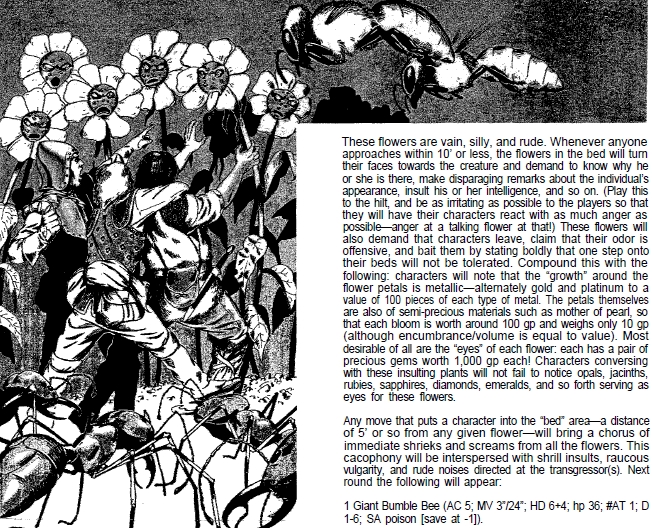
All forms of giant bees are similar to
their ordinary small counterparts.
Honeybees have hives,
bumblees have nests.
If encountered in their lair the hive
will contain 20 times the workers shown by die roll
and 3-12 soldiers.
There will be 7-12 <(d6+6)> bumblebees
in a burrow or nest.
Hives will have a noncombatant queen
and 2-5 noncombatant drones. <drone = ?, statblock & link?>
Nests will have a noncombatant queen of
8+6 HD strong doing 1-8 points of damage per sting.
Poison is normal for workers and stronger
for soldiers and bumblebees (-1 to save). <edit, add to statblock>
A queen bumblebee's poison is -2 for saves.
<? : 'noncombatant'>
Successful save
vs. Poison will inflict an additional 2-8 points damage.
Failure will cause an additional 5-20+1
for soldiers and bumblebees and +2 <5-20+2> for queen bees.
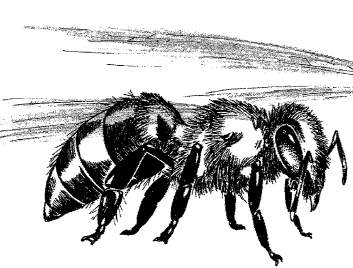
Honey in hives or nests is of proportional
quantities.
Bee "bread"
is excellent food and equal to iron
rations.
"Royal jelly,"
found only 20% of the time,
is equal to 2-5 potions
of extra-healing with a side effect of cure
disease for each.
It can also be made into a sufficient
unguent to treat aging.
The unguent preserves a youthful look
for up to 1 year and 2-5 such preparations can be made from royal jelly.
Charisma will remain unaffected by age
when the unguent is used continually without interruption. <Comeliness>
It is greatly prized by rich and noble
women,
and each unguent jar commands from 3000-8000
gp <d6+2, x 1000> on the open market.
<Note:
age penalties for comeliness
aren't detailed>
<Note:
on the PC record sheets, there is a line for Apparent Age>
Worker
Honeybee
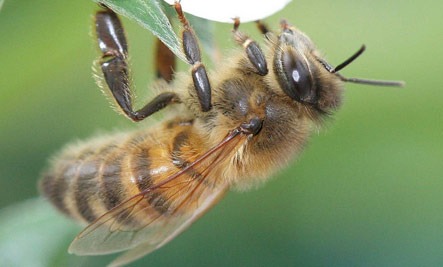
FREQUENCY: Rare
FREQUENCY: Rare ([Temperate Wilderness
Mountains], [Temperate Wilderness Hills], [Temperate Wilderness Forest])
FREQUENCY: Very rare ([Temperate Wilderness
Swamp], [Temperate Wilderness Plains])
FREQUENCY: Rare
([Tropical Wilderness Mountains], [Tropical Wilderness Hills], [Tropical
Wilderness Forest])
FREQUENCY: Very
rare ([Tropical Wilderness Swamp], [Tropical Wilderness Plains])
FREQUENCY: Rare ([Dungeon
Level III])
NO. APPEARING: 1-10
ARMOR CLASS: 6
MOVE: 9" / 30" (MC: D)
HIT DICE: 3+1 <(wings)>
% IN LAIR: 20%
TREASURE TYPE: Nil
NO. OF ATTACKS: 1 (sting)
DAMAGE/ATTACK: 1-3 + poison
SPECIAL ATTACKS: Sting once
SPECIAL DEFENSES: Nil
MAGIC RESISTANCE: Standard
INTELLIGENCE: Low
ALIGNMENT: Neutral
SIZE: M
LEVEL/X.P. VALUE: III | 150 + 4
<all honey bees that are
not queens or drones are "workers" - bigbearomaha>
<honey bees divide their
different tasks/jobs by age - bigbearomaha>
<one of the jobs is "guard
bee" which sort of do a sentry duty at the hive entrance and will aggressively
defend any threat at the entrance and send a pheremone signal inside the
hive to draw other bees to come to guard duty - bigbearomaha>
Soldier
Honeybee
<g=4>
FREQUENCY: Very rare
FREQUENCY: Rare ([Temperate Wilderness
Mountains], [Temperate Wilderness Hills], [Temperate Wilderness Forest])
FREQUENCY: Very rare ([Temperate Wilderness
Swamp], [Temperate Wilderness Plains])
FREQUENCY: Rare
([Tropical Wilderness Mountains], [Tropical Wilderness Hills], [Tropical
Wilderness Forest])
FREQUENCY: Very
rare ([Tropical Wilderness Swamp], [Tropical Wilderness Plains])
FREQUENCY: Rare ([Dungeon
Level III])
NO. APPEARING: 1
ARMOR CLASS: 5
MOVE: 12" / 30" (MC: C)
HIT DICE: 4+2 <(wings)>
% IN LAIR: 90%
TREASURE TYPE: Nil
NO. OF ATTACKS: 1 (sting)
DAMAGE/ATTACK: 1-4 + poison
SPECIAL ATTACKS: Sting once
SPECIAL DEFENSES: Nil
MAGIC RESISTANCE: Standard
INTELLIGENCE: Low
ALIGNMENT: Neutral
SIZE: M
LEVEL/X.P. VALUE: IV | 200 + 5
<no such thing as a "soldier"
honey bee - bigbearomaha>
Queen
Honeybee
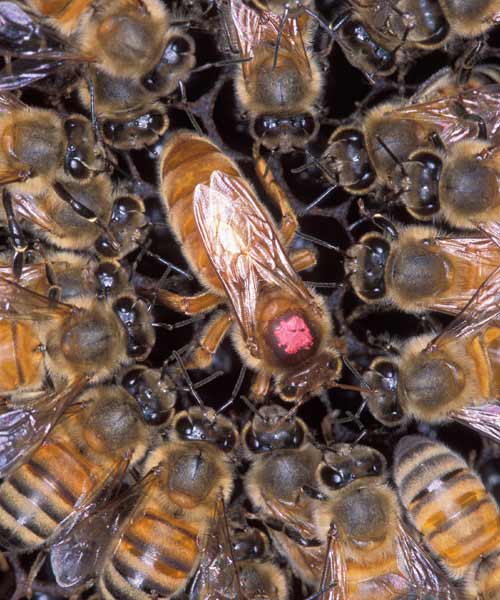
FREQUENCY: Very rare
FREQUENCY: Rare ([Temperate Wilderness
Mountains], [Temperate Wilderness Hills], [Temperate Wilderness Forest])
FREQUENCY: Very rare ([Temperate Wilderness
Swamp], [Temperate Wilderness Plains])
FREQUENCY: Rare
([Tropical Wilderness Mountains], [Tropical Wilderness Hills], [Tropical
Wilderness Forest])
FREQUENCY: Very
rare ([Tropical Wilderness Swamp], [Tropical Wilderness Plains])
FREQUENCY: Rare ([Dungeon
Level III])
NO. APPEARING: 1
ARMOR CLASS: 5
MOVE: 12" / 30"
HIT DICE: 8+6 <(wings)>
% IN LAIR: 100%
TREASURE TYPE: Nil
NO. OF ATTACKS: 0
DAMAGE/ATTACK: 0
SPECIAL ATTACKS: Nil
SPECIAL DEFENSES: Nil
MAGIC RESISTANCE: Standard
INTELLIGENCE: Low
ALIGNMENT: Neutral
SIZE: M
LEVEL/X.P. VALUE: IV | 200 + 5
<the above is from DL3>
<the NO. OF ATTACKS &
DAMAGE/ATTACK (listed as N/A in DL3) do seem to contradict with the general
text, above>
<8+6 probably applies
to both honeyqueens & bumblequeens>
<perhaps, it is only
the bumblequeen that can attack>
<bigbearomaha: the queen
will never attack anything but another queen>
<bigbearomaha: and o
=to other queens they are vicious>
Bumblebee
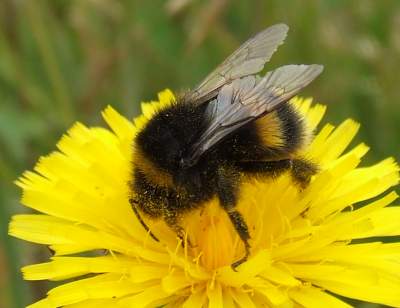
FREQUENCY: Rare
FREQUENCY: Rare
([Dungeon Level V])
FREQUENCY: Rare ([Temperate Wilderness
Mountains], [Temperate Wilderness Hills], [Temperate Wilderness Plains],
[Temperate Wilderness Desert])
FREQUENCY: Very rare ([Temperate Wilderness
Forest], [Temperate Wilderness Swamp])
FREQUENCY: Rare
([Tropical Wilderness Mountains], [Tropical Wilderness Hills], [Tropical
Wilderness Plains], [Tropical Wilderness Desert])
FREQUENCY: Very
rare ([Tropical Wilderness Forest], [Tropical Wilderness Swamp])
NO. APPEARING: 1 <(in lair (nest/burrow):
d6+6)>
ARMOR CLASS: 5
MOVE: 6" / 24" (MC: E)
HIT DICE: 6+4 <(wings)>
% IN LAIR: 10%
TREASURE TYPE: Nil
NO. OF ATTACKS: 1 ~ 13
DAMAGE/ATTACK: 1-6 + poison
SPECIAL ATTACKS: Sting
SPECIAL DEFENSES: Nil
MAGIC RESISTANCE: Standard
INTELLIGENCE: Low
ALIGNMENT: Neutral
SIZE: L
LEVEL/X.P. VALUE: V | 400 + 8
SAVES: 10.11.12.12.13
bigbearomaha: heya bbbigbearomaha: now I see in the MM2 listing that
"giant bees" are size "M"
bigbearomaha: do I assume that is man sized?
prespos: yep
bigbearomaha: then any guard bees at the entrance will first work to
prevent entry and if the intruder continues efforts to get in or threaten
the nest, then they will chew, bite and sting the intruder(s)
bigbearomaha: drawing up to as many as 2000 other bees to aid in the
defense
bigbearomaha: in the case of "killer" bees, that number would quadruple
bigbearomaha: you are in a very bad place when you threaten a bee nest
bigbearomaha: and being man sized, it would be near impossible for
a man sized creature to damage their exoskeleton
prespos: that last one is very interesting .. they are only listed
as AC 5 or 6 or so
anon: so what AC would your give them Bear?
bigbearomaha: at least 0
anon: so superior to steel plate armour?
bigbearomaha: givien they are "giant sized, their exoskeleton would
thicken accordingly
bigbearomaha: it would take a giant or dragon to crush them outright
anon: interesting
prespos: in that case, then they would enjoy weapon vs. AC benefits
..
bigbearomaha: for their respective diminutive size in real life, their
exoskeleton is very much like plate armor to creaqtures their size
prespos: the DMG provides for this: https://dl.dropbox.com/u/22333214/3dmg/wtthan.htm
anon: of course the elephant in the room is
bigbearomaha: even larger wasps, hornets yellow jackets cannot pierce
a bee exoskeleton. they have to go for the more vulnerable throat area
anon: giant bee's would never be able to fly as a normal bee could
bigbearomaha: why not? their wing muscles a would be giant correspondingly
bigbearomaha: now a giant bumblebee might be a different story
bigbearomaha: their flight is shaky to begin with having 3 times the
body mass of a honey bee
anon: it would be the overall weight which would be the problem I'd
think
bigbearomaha: honey bees are much more proportionate in body mass to
wing size than bumblebees
anon: Bear I think the problem is that lifting power never scales up
in a linear fashion
bigbearomaha: if as a beekeeper, I didn't pay attention to minutae
and details, I'd not be a very successful beekeeper
anon: consider the lifting ability of an ant vs that of an elephant
prespos: yep, little things can make a big difference ..
anon: the ant lifts several times its own weight
bigbearomaha: your comparing apples to oranges in those two
anon: the elephant struggles to lift its own weight
bigbearomaha: the muscular structure of ant is very different to that
of an elephant
anon: yes, I know, but the rule is there
bigbearomaha: if one were to take a mamml and make it giant sized,
I could see that argument being made
bigbearomaha: insect musculature is a very differeent thing from mammalian
musculature
anon: I realise that
prespos: yes, bear .. totally different anatomy && physiology
..
prespos: the role of dopamine in insects is particularly fascinating
..
anon: but the truth is, the smaller the animal, the greater the % of
its own weight it can lift/shift
bigbearomaha: sorry, as apest amangement specialist, insects are part
of my ever ongoiing licensing requiremnts
bigbearomaha: that is not always the case though
bigbearomaha: for example, take an aphid
anon: no not always
bigbearomaha: an aphid is not thus proportionally strong
anon: but as a general rule, its largely true
bigbearomaha: it is smaller than an ant
bigbearomaha: in the case of bees, and knowing their biology as I do,
I have no problem seeing a giant honey bee fly as normal


